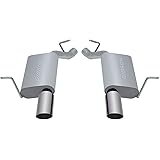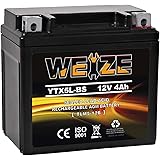Understanding the basics of wastegate control in Honda Civics ===
Gibson Performance Exhaust 17407 Aluminized Axle Back Exhaust System
$436.39 (as of 07/26/2024 05:24 GMT -07:00 - More infoProduct prices and availability are accurate as of the date/time indicated and are subject to change. Any price and availability information displayed on [relevant Amazon Site(s), as applicable] at the time of purchase will apply to the purchase of this product.)Spectre Performance SPE-5772 5772 2V-4V Carburetor Adapter
$11.01 (as of 07/26/2024 05:24 GMT -07:00 - More infoProduct prices and availability are accurate as of the date/time indicated and are subject to change. Any price and availability information displayed on [relevant Amazon Site(s), as applicable] at the time of purchase will apply to the purchase of this product.)Drift Car Air Freshener - Wood Air Freshener - Car Odor Eliminator - Amber Scent Starter Kit
$12.95 (as of 07/26/2024 05:24 GMT -07:00 - More infoProduct prices and availability are accurate as of the date/time indicated and are subject to change. Any price and availability information displayed on [relevant Amazon Site(s), as applicable] at the time of purchase will apply to the purchase of this product.)Vibrant 17950 Stainless Steel Resonator 3 inch
$93.63 (as of 07/26/2024 05:24 GMT -07:00 - More infoProduct prices and availability are accurate as of the date/time indicated and are subject to change. Any price and availability information displayed on [relevant Amazon Site(s), as applicable] at the time of purchase will apply to the purchase of this product.)AP Exhaust Products AP Exhaust 7426CB Muffler
$29.60 (as of 07/26/2024 05:24 GMT -07:00 - More infoProduct prices and availability are accurate as of the date/time indicated and are subject to change. Any price and availability information displayed on [relevant Amazon Site(s), as applicable] at the time of purchase will apply to the purchase of this product.)Weize YTX5L-BS High Performance - Maintenance Free - Sealed AGM Motorcycle CTX5L Battery compatible with Honda YUASA Yamaha ETX5L-BS Batteries
$26.99 (as of 07/26/2024 05:24 GMT -07:00 - More infoProduct prices and availability are accurate as of the date/time indicated and are subject to change. Any price and availability information displayed on [relevant Amazon Site(s), as applicable] at the time of purchase will apply to the purchase of this product.)Turbocharging has become a popular choice for car enthusiasts looking to squeeze out maximum performance from their engines. The 6th generation Honda Civic, with its agile handling and sleek design, is no exception to this trend. However, to truly harness the power of a turbocharged engine, one must first understand the basics of wastegate control. In simple terms, the wastegate is a valve that controls the amount of exhaust gases flowing through the turbocharger. This valve plays a crucial role in maintaining the optimal boost pressure for the engine. In this article, we will delve into the intricacies of wastegate control and explore the process of optimizing it for turbocharged applications in a 6th generation Honda Civic.
== Exploring the importance of wastegate optimization in turbocharged engines ==
Wastegate optimization is not merely an optional upgrade for turbocharged engines; it is a necessity. A poorly optimized wastegate control system can lead to subpar performance, decreased fuel efficiency, and even potential engine damage. By fine-tuning the wastegate control, car owners can maximize the power output of their turbocharged Civic while ensuring the engine operates within safe limits. Optimizing wastegate control allows for a more precise control of the boost pressure, resulting in improved throttle response, better torque delivery, and an overall exhilarating driving experience.
== Step-by-step guide to optimizing wastegate control in 6th gen Honda Civic ==
-
Understanding the stock wastegate setup: Begin by familiarizing yourself with the stock wastegate control system in your 6th generation Honda Civic. This will help identify any limitations or potential areas for improvement.
-
Upgrading the wastegate actuator: Consider upgrading the wastegate actuator if you find that the stock actuator is unable to control the boost pressure effectively. A stiffer actuator spring can provide more precise control over the wastegate valve, ensuring optimal boost pressure levels.
-
Adjusting the wastegate preload: Fine-tuning the wastegate preload helps achieve the desired boost pressure levels. By adjusting the wastegate arm length or the actuator rod, the wastegate can be set to open at the desired pressure, allowing for better control and performance.
-
Using a boost controller: Installing an electronic boost controller provides even greater control over the wastegate operation. It allows for adjustable boost levels and can be easily tuned to match the desired performance characteristics.
-
Monitoring and logging data: Use a data logging tool to monitor and analyze the boost pressure, exhaust gas temperatures, and other relevant parameters. This data will help fine-tune the wastegate control settings and ensure optimal performance.
-
Iterative adjustments and testing: Optimizing wastegate control is not a one-time process. It requires iterative adjustments and testing to find the perfect balance between performance and reliability. Make small incremental changes, record the results, and keep refining the settings until the desired performance is achieved.
== Common issues and troubleshooting techniques for wastegate control ==
Even with proper optimization, wastegate control systems can encounter issues. One common problem is "boost creep," where the boost pressure exceeds the desired level due to a poorly regulated wastegate. To address this issue, check for leaks in the wastegate plumbing and ensure the wastegate actuator is functioning correctly.
Another issue is "boost lag," where there is a delay in achieving the desired boost pressure. This can occur due to a slow-acting wastegate actuator or inadequate wastegate preload. Adjusting the wastegate arm length or upgrading to a stiffer actuator spring can help minimize boost lag.
== Tips and tricks for achieving maximum performance with wastegate control ==
-
Regular maintenance and inspection: Keep a close eye on the wastegate control system, ensuring that all components are in good condition. Regular cleaning and lubrication will prevent any issues caused by dirt or corrosion.
-
Seek professional help if needed: While optimizing wastegate control can be a DIY project, seeking assistance from a professional tuner or mechanic can provide valuable insights and expertise. They can help fine-tune the system and ensure maximum performance without compromising reliability.
-
Consider upgrading other components: Upgrading other components in the turbocharging system, such as the intercooler or wastegate, can complement the wastegate control optimization process. This holistic approach can unleash the full potential of your Honda Civic’s turbocharged engine.
== Frequently asked questions about wastegate control in turbocharged Civics ==
-
Can wastegate control affect fuel economy?
Yes, wastegate control optimization can improve fuel economy by ensuring the engine operates within the optimal boost pressure range. This prevents the engine from working harder than necessary, leading to better fuel efficiency. -
Is wastegate control modification legal?
Wastegate control modifications should comply with local emission laws and regulations. It is important to ensure that any modifications made adhere to the legal limits and do not exceed emissions standards. -
How often should wastegate control be optimized?
Wastegate control optimization should be performed whenever there is a significant change in the turbocharging system, such as upgrading components or tuning the engine. Regular monitoring and adjustments may also be required to maintain optimal performance.
==OUTRO:==
By understanding the basics of wastegate control, exploring its importance in turbocharged engines, and following a step-by-step guide to optimization, 6th generation Honda Civic owners can unlock the true potential of their turbocharged engines. Troubleshooting techniques, tips, and tricks, along with addressing common issues, will ensure a smooth and exhilarating driving experience. So, waste no time and optimize your wastegate control for a thrilling turbocharged journey in your Honda Civic!





